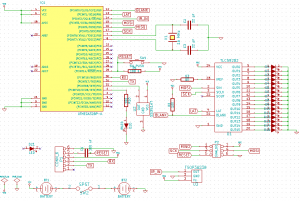Now with the schematic done and all the component mapping done, it’s time to work on the board layout. In my experience with this project, this is an iterative part that takes a lot of time. Laying out a board for most projects may be easier, but for this, I had several restrictions that made it even more challenging.
First, due to the function of the board, I had to place all the LEDs in a very specific place. With this version of the board, I have the same restriction, but it will hopefully be less of a problem since the LEDs are hooked to the LED driver instead of the processor and the pin layout for the LED driver looks like it will make the routing much easier.
Second, since I’m spinning the board at a fairly high speed (1,800 rpm to update the display 30 times per second), I also need to plan where the center of balance is and make sure I can drill a hole there with enough clearance that it doesn’t touch anything else. This ends up being fairly critical and part of the iterative nature of this project. The previous version of this project has 2 AAA batteries on one end of the board with the center of balance near the end of the batteries that’s towards the center. If I switch to a LiPo battery, that center changes. I could instead use a single battery, but would have to rotate it to be parallel to the short side of the board (currently 2″ x 6″ or hopefully 1″ x 6″) so that it could still be spun around without being off balance. That could let me reduce the length of the board, so production costs would be smaller. But that also might require me to go back to adding a DC-DC converter, which I don’t want to deal with right now though. I could put the two AAA batteries directly in the middle of the board, but that means that the LEDs wouldn’t be as far away from the center of rotation. But, it does give me the option of putting LEDs on both sides of the board and spinning the board at half the speed. Or I could shift the LEDs on one side just a little to double the apparently DPI.
For now though, I’ll go back to my tried and true method of both batteries on one side of the board parallel to the long edge of the board. It looks like I won’t be able to shrink the width down to 1″ to save $30 from OSH Park, but it does mean that I’ll get the board done sooner.

